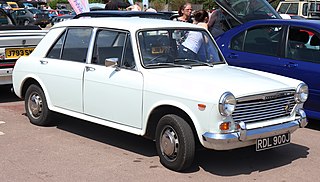 W
WThe BMC ADO16 is a range of small family cars built by the British Motor Corporation (BMC) and, later, British Leyland. Launched in 1962, it was Britain's best-selling car from 1963 to 1966 and from 1968 to 1971. The ADO16 was marketed under various make and model names; however, the Austin 1100 and Morris 1100 were the most prolific of all the ADO16 variants.
 W
WThe Austin Allegro is a small family car that was manufactured by the Austin-Morris division of British Leyland from 1973 until 1982. The same vehicle was built in Italy by Innocenti between 1974 and 1975 and sold as the Innocenti Regent. The Allegro was designed as a replacement for the Austin 1100 and 1300 models. In total, 642,350 Austin Allegros were produced during its ten-year production life, most of which were sold on the home market, less than a third of 2.1 million 1100s and 1300s sold in the previous 11 years.
 W
WThe Austin Ambassador is a large family car that was introduced by the Austin Rover Group subsidiary of British Leyland in March 1982. The vehicle was a heavily updated version of the Princess, a saloon car that had lacked a hatchback. Only the doors and inner structure were carried over, but the wedge-shaped side profile betrayed the car's Princess origins, and it was not considered a truly new model. The Princess had been out of production for four months by the time that the Ambassador went on sale.
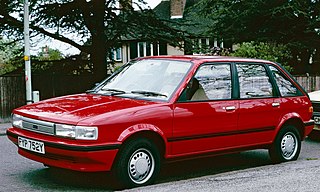 W
WThe Austin Maestro is a five-door hatchback small family car that was produced from 1982 to 1987 by British Leyland, and from 1988 until 1994 by Rover Group, as a replacement for the Morris Marina and Austin Allegro. The car was produced at Morris' former Oxford plant, also known as Cowley, with 605,000 units sold. Today, the redeveloped factory builds the BMW Mini. An MG-branded performance version was sold as the MG Maestro from 1983 until 1991.
 W
WThe Austin Maxi is a medium-sized, 5-door hatchback family car that was produced by Austin and later British Leyland between 1969 and 1981. It was the first British five-door hatchback.
 W
WThe Austin Montego is a British family car that was produced by British Leyland from 1984 until 1988, and then by Rover Group from 1988 until 1995. The Montego was the replacement for both the rear-wheel drive Morris Ital and the front-wheel drive Austin Ambassador ranges to give British Leyland an all-new competitor for the Ford Sierra and Vauxhall Cavalier.
 W
WThe British Rail Class 155 is a diesel multiple-unit passenger train. These DMUs were built by Leyland Bus at Workington between 1987 and 1988 as part of BR's replacement of its ageing first-generation diesel fleet. 42 units were originally built, of which only 7 remain; the other 35 units were converted to Class 153 railcars.
 W
WThe Jaguar XJ is a series of full-size luxury cars produced by British automobile manufacturer Jaguar Cars from 1968 to 2019. It was produced across five basic platform generations with various updated derivatives of each. From 1970 it was Jaguar's flagship four door model. The original model was the last Jaguar saloon to have had the input of Sir William Lyons, the company's founder, and the model has been featured in countless media and high-profile appearances.
 W
WThe Jaguar XJ-S is a luxury grand tourer manufactured and marketed by British car manufacturer Jaguar Cars from 1975 to 1996, in coupé, fixed-profile and full convertible bodystyles. There were three distinct iterations, with a final production total of 115,413 units over 20 years and seven months.
 W
WThe Leyland P76 is a large car that was produced by Leyland Australia, the Australian subsidiary of British Leyland. Featuring what was described at the time as the "standard Australian wheelbase of 111 inches", it was intended to provide the company with a genuine rival to large local models like the Ford Falcon, the Holden Kingswood, and the Chrysler Valiant. But, due to the first real fuel crisis and demand far exceeding the supply, Leyland rushed the assembly process with the first of the P76s to come off the assembly line, resulting in poor build quality and some reliability problems. The combination of the rushed assembly, fuel crisis and strikes at the component manufacturers' factories, resulted in the Leyland P76 being labelled a lemon, despite receiving the Wheels magazine Car of the Year in 1973. By 1974, sales of the P76 had slumped and BMC decided to end the production of the P76. Although the P76 has been labelled a lemon in Australian motoring history, it is viewed by some as an iconic Australian car and has a loyal following.
 W
WThe LDV Pilot is a panel van that was produced by LDV Limited from 1996 until 2006, and closely based on preceding models dating back to the 1974 Leyland Sherpa.
 W
WThe Mini is a two-door compact city car that was produced by the British Motor Corporation (BMC) and its successors from 1959 until 2000. The original Mini is considered an icon of 1960s British popular culture. Its space-saving transverse engine and front-wheel drive layout – allowing 80% of the area of the car's floorpan to be used for passengers and luggage – influenced a generation of car makers. In 1999, the Mini was voted the second-most influential car of the 20th century, behind the Ford Model T, and ahead of the Citroën DS and Volkswagen Beetle. The front-wheel-drive, transverse-engine layout of the Mini was copied for other "supermini" designs including the Honda N360 (1967), Nissan Cherry (1970), and Fiat 127 (1971). The layout was also adapted for larger subcompact designs.
 W
WThe Mini is a two-door compact city car that was produced by the British Motor Corporation (BMC) and its successors from 1959 until 2000. The original Mini is considered an icon of 1960s British popular culture. Its space-saving transverse engine and front-wheel drive layout – allowing 80% of the area of the car's floorpan to be used for passengers and luggage – influenced a generation of car makers. In 1999, the Mini was voted the second-most influential car of the 20th century, behind the Ford Model T, and ahead of the Citroën DS and Volkswagen Beetle. The front-wheel-drive, transverse-engine layout of the Mini was copied for other "supermini" designs including the Honda N360 (1967), Nissan Cherry (1970), and Fiat 127 (1971). The layout was also adapted for larger subcompact designs.
 W
WThe Mini is a two-door compact city car that was produced by the British Motor Corporation (BMC) and its successors from 1959 until 2000. The original Mini is considered an icon of 1960s British popular culture. Its space-saving transverse engine and front-wheel drive layout – allowing 80% of the area of the car's floorpan to be used for passengers and luggage – influenced a generation of car makers. In 1999, the Mini was voted the second-most influential car of the 20th century, behind the Ford Model T, and ahead of the Citroën DS and Volkswagen Beetle. The front-wheel-drive, transverse-engine layout of the Mini was copied for other "supermini" designs including the Honda N360 (1967), Nissan Cherry (1970), and Fiat 127 (1971). The layout was also adapted for larger subcompact designs.
 W
WThe Mini Moke is a small, front-wheel-drive utility and recreational convertible, manufactured and marketed originally by British Motor Corporation (BMC), and subsequently marketed under the Austin, Morris and Leyland brands.
 W
WThe Minissima is a small concept city car that was designed by William Towns as his idea for a replacement for the Mini in 1972. It was displayed by BLMC on their stand at the 1973 London Motor Show after they bought the prototype from Towns.
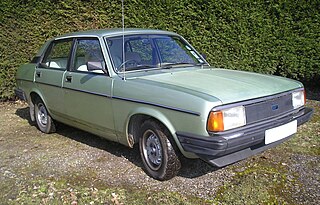 W
WThe Morris Ital is a medium-sized car that was built by British Leyland (BL) from 1980 to 1984. A successor to the Morris Marina, it was available in a variety of bodystyles.
 W
WThe Morris Marina is a front-engined, rear-wheel-drive small family car that was manufactured by the Austin-Morris division of British Leyland from 1971 until 1980. It served to replace the Morris Minor in the Morris product line, which had first been built in 1948. The Marina was also sold in some markets as the Austin Marina, the Leyland Marina and the Morris 1700.
 W
WThe Morris Nomad is a car that was produced in Australia by British Leyland Motor Corporation of Australia from 1969 to 1972. It is a hatchback version of the Morris 1500 sedan, itself a locally produced variant of the British BMC ADO16 design with a larger 1500 cc engine.
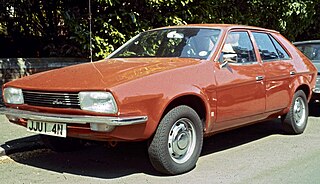 W
WThe Princess is a large family car produced in the United Kingdom by the Austin-Morris division of British Leyland from 1975 until 1981. The car inherited a front-wheel drive / transverse engine configuration from its predecessor, the Austin/Morris 1800 range. This was still unusual in Europe for family cars of this type and gave the Princess a cabin space advantage when compared with similarly sized cars from competing manufacturers.
 W
WThe Princess is a large family car produced in the United Kingdom by the Austin-Morris division of British Leyland from 1975 until 1981. The car inherited a front-wheel drive / transverse engine configuration from its predecessor, the Austin/Morris 1800 range. This was still unusual in Europe for family cars of this type and gave the Princess a cabin space advantage when compared with similarly sized cars from competing manufacturers.
 W
WThe Range Rover Classic is a 4x4, mid-size Sport utility vehicle series produced from 1969 to 1996 – initially by the Rover division of British Leyland, and latterly by the Rover Group.
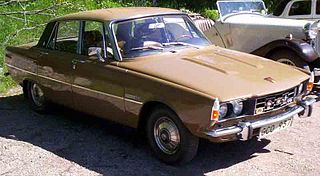 W
WThe Rover P6 series was a saloon car produced by Rover and subsequently British Leyland from 1963 to 1977 in Solihull, West Midlands, England, UK.
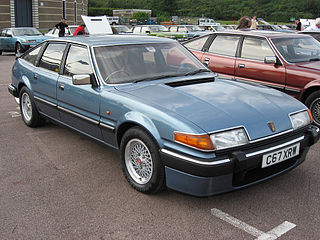 W
WThe Rover SD1 is both the code name and eventual production name given to a series of executive cars built by the Specialist Division of British Leyland (BL), under the Rover marque. It was produced through its Specialist, Rover Triumph and Austin Rover divisions from 1976 until 1986, when it was replaced by the Rover 800. The SD1 was marketed under various names. In 1977 it won the European Car of the Year title.
 W
WThe Triumph Acclaim is a front-wheel drive compact family saloon/sedan manufactured by British Leyland (BL) from 1981 to 1984. It is based on the Honda Ballade. It used a Honda-designed engine, was manufactured under license from Honda, and met United Kingdom component-content requirements. It was the final model of the Triumph marque.
 W
WThe Triumph Dolomite small saloon car was produced by the Triumph Motor Company division of the British Leyland Corporation in Canley, Coventry between October 1972 and August 1980.
 W
WThe Triumph Spitfire is a British front-engined, rear-wheel drive, two-passenger convertible sports car introduced at the London Motor Show in 1962 and manufactured between 1962-1980. Styled for Standard-Triumph in 1957 by Italian designer Giovanni Michelotti, the Spitfire was manufactured for the duration of its production at the Standard-Triumph Canley works — and evolved over a series of five production iterations, with a approximately 315,000 manufactured over 18 years.
 W
WThe Triumph Stag is a 2+2 sports tourer which was sold between 1970 and 1978 by the Triumph Motor Company, styled by Italian designer Giovanni Michelotti.
 W
WThe Triumph Toledo is a compact car which was produced by the Rover-Triumph division of British Leyland in the United Kingdom from 1970 to 1976.
 W
WThe Triumph TR7 sports car was manufactured in the United Kingdom from September 1974 to October 1981, until May 1975, by the Rover-Triumph Division of the British Leyland Motor Corporation (BLMC) and, thereafter, by the Specialist Division of British Leyland (BL). It was initially produced at the Speke, Liverpool, factory, moving to Canley, Coventry, in 1978 and then finally to the Rover Solihull plant in 1980. The car was launched in the United States in January 1975, with its UK home market debut in May 1976. The UK launch was delayed at least twice because of high demand for the vehicle in the US, with final sales of new TR7s continuing into 1982.
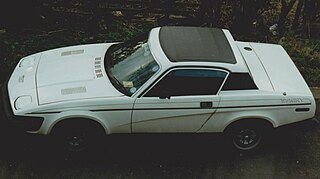 W
WThe Triumph TR7 Sprint version of the Triumph TR7 sports car was produced in 1977 by the Triumph Motor Company then part of British Leyland. However, it was produced in only very limited numbers: Probably a maximum of 61 in total were manufactured. It used the 127 bhp, 16-valve, 2-litre version of the Triumph slant-four engine from the Triumph Dolomite Sprint, a highly tuned version of which, "rated at 225 bhp at 8000 rpm" by 1977, was used in the Group 4 TR7 cars of the BL works rally team, from 1976 until 1978. This was instead of the TR7 base model's 105 bhp, 8-valve, 2-litre version of the same basic slant-4 engine. The 16-valve version was originally specified in the Dolomite Sprint at 135 bhp, and "Spenser King relates how he went away on holiday and came back to find an engine running on the bed giving 150 bhp at the first build."